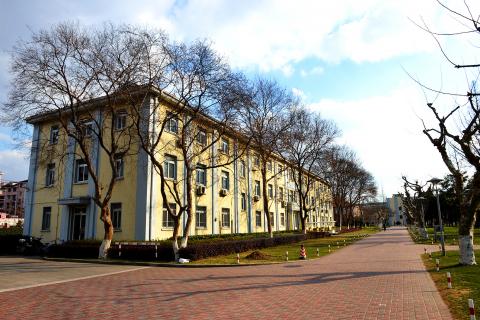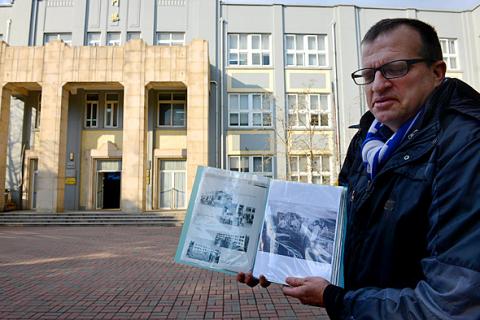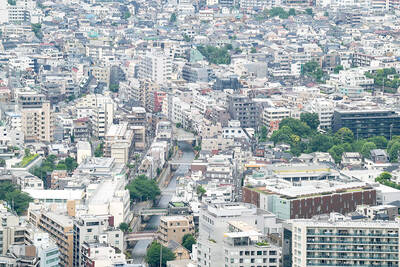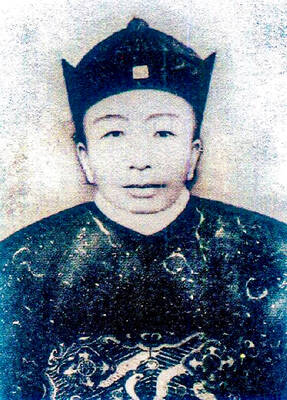No public memorial marks the former Shanghai internment camp made famous by JG Ballard’s novel Empire of the Sun, where more than 1,800 foreigners were held by the Japanese during World War II.
Ballard’s fictionalized version of his experiences in the Lunghwa camp was published 30 years ago, followed in 1987 by the Steven Spielberg film starring a young Christian Bale as Jim Graham, a boy who comes of age on his own in the facility.
The site is now an elite government-run school in Shanghai’s southern suburbs, where Chinese students are unaware internees once slept in their grey classroom buildings.

Photo: AFP
The only reminder is a small, easily-ignored display in a private campus museum.
“When I studied here, I was not aware of this part of history. It was not mentioned in class,” said Shanghai High School graduate Lucy Zhang.
The Chinese government, embroiled in a territorial dispute with Tokyo, regularly publicizes Japanese atrocities against its people from the 1930s to the end of World War II.

Photo: AFP
A far smaller number of foreigners lived in China at the time, but their sufferings have gone largely ignored.
An American teacher at the school, Sven Serrano, is trying to change that, lecturing on the history of the camp to foreign students in the school’s international section, showing visitors around and developing an online app about the site.
The school demolished the former G Block, where Ballard lived with his family, to make space for a swimming pool, but eight other buildings still stand, including the dining hall and assembly center, Serrano said.
“I’m always concerned that I’ll wake up one morning and the wrecking ball has been taken to one of our precious old buildings,” he told AFP.
“I don’t see any way how we’re going to have any memorial plaque. They just don’t want to make a really big deal of it,” he said — adding one reason for the sensitivity was Japanese students attending the school.
Former internee Betty Barr entered the Lunghwa camp in 1943 at the age of 10 with her Scottish missionary father, American mother and older brother.
Her most vivid memories are blistering summers, freezing winters and an obsession with food.
“I was old enough to know what was happening. I didn’t think it was a picnic,” said Barr, 80, during a return visit.
She still guiltily recalls taking a sip of milk produced by the camp’s only cow from a mug she was taking to her brother in the hospital.
“My father rose to be the manager of the kitchen, though he could not boil an egg, because he could be trusted not to steal vegetables,” she said.
A TIME TO REMEMBER
Japan set up more than 20 internment camps holding around 14,000 people in China and Hong Kong, then a British colony, according to Greg Leck, author of Captives of Empire about the Japanese internment of Allied civilians from 1941 to 1945.
Shanghai, an international commercial city where overseas citizens enjoyed legal privileges and comfortable lifestyles in foreign “concessions,” had 12 camps.
“Hunger and malnutrition, more than anything else, made conditions more severe,” he said. “Medical service personnel were confronted with every type of ailment … aggravated by lack of clothing, poor housing, poor sanitation, over-crowding and the stresses associated with captivity.”
On a vastly larger scale, Japan held both civilians and prisoners of war in 176 camps in its own country and 500 in occupied territories during the war. Japan was also responsible for the deaths of as many as 30 million Asians, including Chinese, his research showed.
Many former China internees have taken issue with Empire of the Sun over factual inaccuracies, uncomplimentary portrayals of recognizable people and the feeling that Ballard appropriated a story belonging to them.
“What upset many former inmates was that his hero, Jim, admired the Japanese,” said Barr, who knew Ballard. “I didn’t mind that but felt that some of what he wrote was not related to the reality. The film was even further removed.”
Ballard, who died in 2009, said his best-known novel was based on memories.
“Some of the events that I described are imaginary, but ... Empire of the Sun is a novel that is firmly based on true experiences, either my own or those told to me by other internees,” he wrote in his autobiography Miracles of Life.
The novel came out 40 years after the events it depicted, but the writer explained: “It took me 20 years to forget Shanghai and 20 years to remember.”

The canonical shot of an East Asian city is a night skyline studded with towering apartment and office buildings, bright with neon and plastic signage, a landscape of energy and modernity. Another classic image is the same city seen from above, in which identical apartment towers march across the city, spilling out over nearby geography, like stylized soldiers colonizing new territory in a board game. Densely populated dynamic conurbations of money, technological innovation and convenience, it is hard to see the cities of East Asia as what they truly are: necropolises. Why is this? The East Asian development model, with

June 16 to June 22 The following flyer appeared on the streets of Hsinchu on June 12, 1895: “Taipei has already fallen to the Japanese barbarians, who have brought great misery to our land and people. We heard that the Japanese occupiers will tax our gardens, our houses, our bodies, and even our chickens, dogs, cows and pigs. They wear their hair wild, carve their teeth, tattoo their foreheads, wear strange clothes and speak a strange language. How can we be ruled by such people?” Posted by civilian militia leader Wu Tang-hsing (吳湯興), it was a call to arms to retake

Desperate dads meet in car parks to exchange packets; exhausted parents slip it into their kids’ drinks; families wait months for prescriptions buy it “off label.” But is it worth the risk? “The first time I gave him a gummy, I thought, ‘Oh my God, have I killed him?’ He just passed out in front of the TV. That never happens.” Jen remembers giving her son, David, six, melatonin to help him sleep. She got them from a friend, a pediatrician who gave them to her own child. “It was sort of hilarious. She had half a tub of gummies,

The wide-screen spectacle of Formula One gets a gleaming, rip-roaring workout in Joseph Kosinski’s F1, a fine-tuned machine of a movie that, in its most riveting racing scenes, approaches a kind of high-speed splendor. Kosinski, who last endeavored to put moviegoers in the seat of a fighter jet in Top Gun: Maverick, has moved to the open cockpits of Formula One with much the same affection, if not outright need, for speed. A lot of the same team is back. Jerry Bruckheimer produces. Ehren Kruger, a co-writer on Maverick, takes sole credit here. Hans Zimmer, a co-composer previously, supplies the thumping